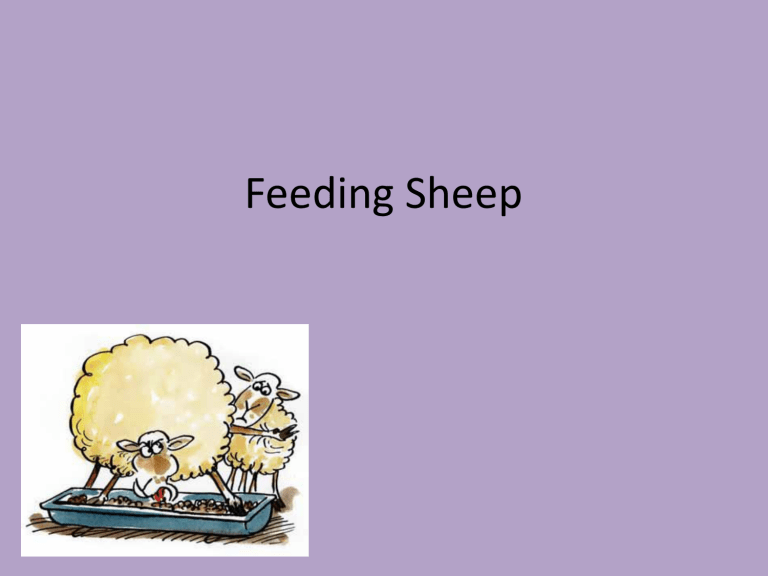Sheep Feeding Guide: Rations, Supplements, and Strategies
advertisement

Feeding Sheep Sheep Concentrated feed ration Roughage Hay – Dried grass 10-15% Moisture Silage – Fermented grass 75% moisture Grass Supplements Dry Ewe Usually kept on pasture If grass is long enough it is sufficient to maintain the condition of the ewes Flushing - Helps to improve the body condition of thin ewes Ewes can be flushed 2 -3 weeks before rams are introduced Use of good grazing and supplementary feeding to improve condition score Pregnancy Early – mid pregnancy Avoid any sudden changes in diet for the first 3 weeks 2 – 3 months All ewes are scanned to check how many lambs they are carrying – Why? Ewes carrying triplets need supplementary feed earlier than twins & singles 70% of foetal development takes place in the last 8 weeks of pregnancy - Energy and protein requirements increase rapidly - The requirements more than double if the ewe has twins - As the lambs develop the stomach is compressed - Ewe is unable to eat in bulk - Nutrient density of the ration must increase Supplementary feeding should begin 6-8 weeks before lambing Supplements can be given e.g. High energy blocks or liquids - Whirlow give high energy & fish oil supplements Avoid sudden changes to the diet in the last 3 weeks - Prone to metabolic diseases e.g. Twin lamb disease or Hypocalcaemia Vitamin E Important for strong lambs at birth - Supplementation of vitamin E is recommended Ewes can be given - 80iu/kg for lowland ewes - 120iu/kg for hill ewes Ewes should also be given ad lib access to hay, silage or straw Water Dry ewes – Approx 4-5 litres per day Lactating ewes – Approx 9 litres per day Ad lib access to fresh water is very important! Example of Supplementary feeding Weeks before lambing 8-6 6-4 4-2 2-lambing 0.5kg 0.75kg 0.9kg 1kg Never feed more than 0.5kg as one feed, split rations into 2-3 smaller rations Rams Kept on pasture when not tupping - Can be fed silage/pellets during the winter if needed Start Feeding concentrate ration 6 -8 weeks before tupping (8-10 if possible) -Feed 1kg of high quality ration, 18 – 20% protein - Continue to feed during tupping Lambs New born - 50ml of colostrum per kg of body weight needed in the first 6hrs of life - In 24 hours lambs need 10% of their body weight in colostrum Colostrum contains concentrated energy and other nutrients (vit E) and acts as a laxative Weaning • Lambs are usually weaned at 12 – 16 weeks of age • They can be turned out onto good pasture • By providing good quality grass at a sward height of 6-7cm, creep feeding can be avoided Creep Feeding Creep pellets are offered as lambs are starting to wean - Offered ad lib in a creep feeder - Lambs should be grouped by weight at weaning Finishing Lambs can be finished on good pasture Lambs fed creep feed can eat up to 40 – 50kg and will finish quicker Late finishers will need supplementary feeding through winter, either with crops or indoors with hay/silage and pellets Equipment Questions?

